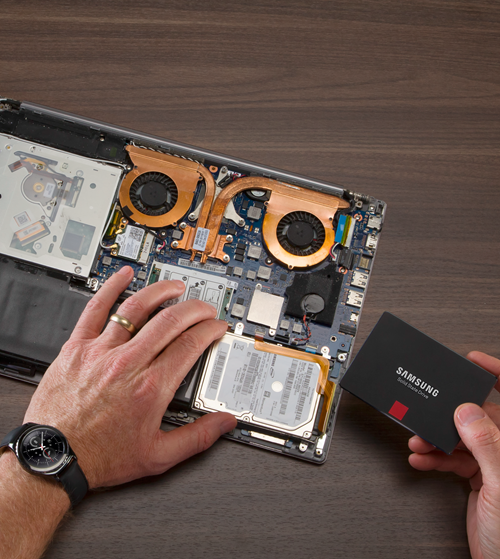Organizations are building more data centers than ever to meet the needs of a data-driven digital economy. Data center inventory grew 17 percent in 2021 to 3,358 megawatts (MW) of data center capacity across the major North American markets, according to CBRE1. But as companies increase their data center capacity, they are also seeking to reduce the environmental impact of their IT infrastructure.
Enterprises can build more sustainable data centers and lower their carbon footprint through multiple approaches, including powering their facilities with renewable energy and using more energy-efficient equipment, or from installing cooling systems and LED lighting. They can also replace hard disk drives (HDDs) with more power-efficient solid state drives (SSDs).
Fighting climate change with greener data centers
Data center operators are increasingly focused on sustainability as a matter of corporate policy to combat climate change. Their customers and employees are demanding it more and more as well. In fact, a recent Deloitte2 survey of 2,000 C-level executives found that 97 percent of companies have felt the impact of climate change, from operational and supply chain disruptions to increased employee anxiety. Two-thirds of them pledged that their companies will achieve net-zero emissions by 2030.
Prepare for your storage upgrade
Which form factors and interfaces make the most sense for your company's storage needs? Download Now
Data centers consume a lot of energy. The largest data centers can require more than 100 megawatts of power capacity, which is enough electricity to power 80,000 U.S. households, according to the U.S. Department of Energy3. In fact, data centers could produce up to 3.2 percent of all global carbon emissions by 2025, according to one study4.
To become more environmentally conscious, executives surveyed by Deloitte said their top strategies are to use more sustainable materials (67 percent), increasing energy efficiency (66 percent) and using energy-efficient or climate-friendly technologies and equipment (57 percent).
Part of the solution is to adopt data center technology (DCT) SSDs, such as the Samsung PM9A3 and PM893, which provide faster performance than old-fashioned HDDs. This makes them ideal for high-performance needs, such as content delivery networks (CDNs), data analytics, artificial intelligence and Internet of Things (IoT) applications. They also operate more efficiently, resulting in reduced power and cooling needs. Here’s how.
How SSDs drive sustainability
SSDs greatly reduce data center carbon emissions because they use less power and require less cooling than HDDs. Since SSDs come in 2.5-inch or M.2 form factors, are smaller drives, and with no moving parts, they consume less energy and produce less heat than 3.5-inch spinning disk drives.
SSDs are also built with less hazardous materials, which makes them more environmentally friendly, according to TechTarget5.
“Removing the mechanical component of spinning disk eliminates the rotational speed as a performance factor, heat generation and overall power consumption, which can provide measurable [cost] savings as well,” said Alicia Johnson, a principal in the technology transformation practice at advisory firm EY in the TechTarget article.
The Samsung family of DCT SSDs are extremely power-efficient. For example, the Samsung NVMe® SSD PM9A3, in a U.2 form factor with 960 GB to 7.68 TB of storage capacity, uses up to 11.0 watts for active reads, up to 13.5 watts for active writes and up to 3.5 watts while idle. Meanwhile, the Samsung SATA SSD PM893, in a 2.5-inch form factor with 7.68 TB, uses 2.1 watts for active reads, 3.2 for active writes and 1.5 watts for idle power consumption.
Storage consumes 11 percent of the power in a data center, ranking behind cooling systems and servers, both of which account for 43 percent of the power used in data centers, according to the non-profit Aspen Global Change Institute6. So reducing energy consumption by migrating from HDDs to SSDs in a data center could make a substantial difference, not just from a storage hardware standpoint but also in reducing cooling needs.
The Samsung family of PM9A3 and PM893 data center SSDs can provide enterprises with multiple benefits. They are faster than HDDs and are a high-performance storage solution for servers. They also operate more efficiently, resulting in reduced power and cooling needs, which in turn reduces their carbon footprint.
Explore Samsung’s full range of award-winning, cutting edge SSDs. And get your free white paper on how SSDs protect sensitive company data with hardware-level data encryption.
1 CBRE, “North America Data Center Trends H2”. 2021
2 Deloitte, “Deloitte 2022 CxO Sustainability Report” 2022
3 Aspen Global Change Institute. “How much energy do data centers really use?” March 2020.
4 The Guardian. “‘Tsunami of data’ could consume one fifth of global electricity by 2025.” December 11, 2017.
5 TechTarget. “3 ways to ease the green data storage transition.” November 6, 2020.
6 3 Aspen Global Change Institute. “How much energy do data centers really use?” March 2020.








